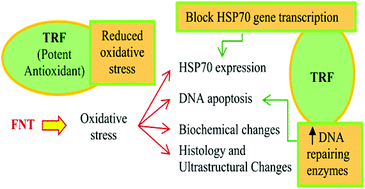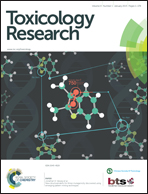Palm oil tocotrienol-rich fraction attenuates testicular toxicity induced by fenitrothion via an oxidative stress mechanism
Abstract
Palm oil tocotrienol-rich fraction (TRF) is a well known antioxidant that has shown potential in reducing oxidative stress under various pathological conditions. Exposure to organophosphates such as fenitrothion (FNT) has been reported to cause testicular oxidative damage. The present study was conducted to determine whether TRF could prevent this testicular damage. Parameters evaluated included the oxidative stress status, heat shock protein-70 (HSP70) expression, germ cell apoptosis, reproductive biochemical levels, and morphological alteration. Mature male Sprague-Dawley rats (n = 40) were given FNT (20 mg kg−1), TRF (200 mg kg−1) and TRF + FNT daily via gavage for 28 consecutive days. Co-administration of TRF in FNT-treated rats increased the activities of enzymatic antioxidants such as superoxide dismutase, catalase, and glutathione s-transferase (p < 0.05). TRF also increased the ferric reducing antioxidant power (FRAP) as well as the levels of non-enzymatic antioxidants such as glutathione, compared with the FNT group alone (p < 0.05). Further, TRF reduced lipid peroxidation and protein oxidation by significantly lowering the malondialdehyde and protein carbonyl levels in FNT-treated rats (p < 0.01). HSP70 expression and apoptotic germ cell count in the testis were significantly reduced in the TRF + FNT group (p < 0.05). TRF also ameliorated the biochemical changes in rat testis by reducing sialic acid, total cholesterol, and total protein at p < 0.05. Histological and ultrastructural observations revealed that supplementation with TRF improved the morphological changes in testis in the TRF + FNT group. In conclusion, TRF was able to partially mitigate testicular damage in FNT-intoxicated rats.


 Please wait while we load your content...
Please wait while we load your content...